Scarecrows have guarded crops since ancient farmers first tied reeds into humanoid shapes, and their charm endures because the idea still works— as long as you keep surprising the birds. Modern materials, motion sensors, and up-cycling trends mean today’s garden scarecrow can be both effective and delightfully creative. From straw-stuffed tradition to laser-lit tech, the twenty concepts below show how a garden scarecrow can double as a pest shield, a family craft, and a focal piece that celebrates your plot’s personality. Pick one or mix several to keep your produce safe and your visitors smiling.
1. Classic Straw-Stuffed Scarecrow Frame
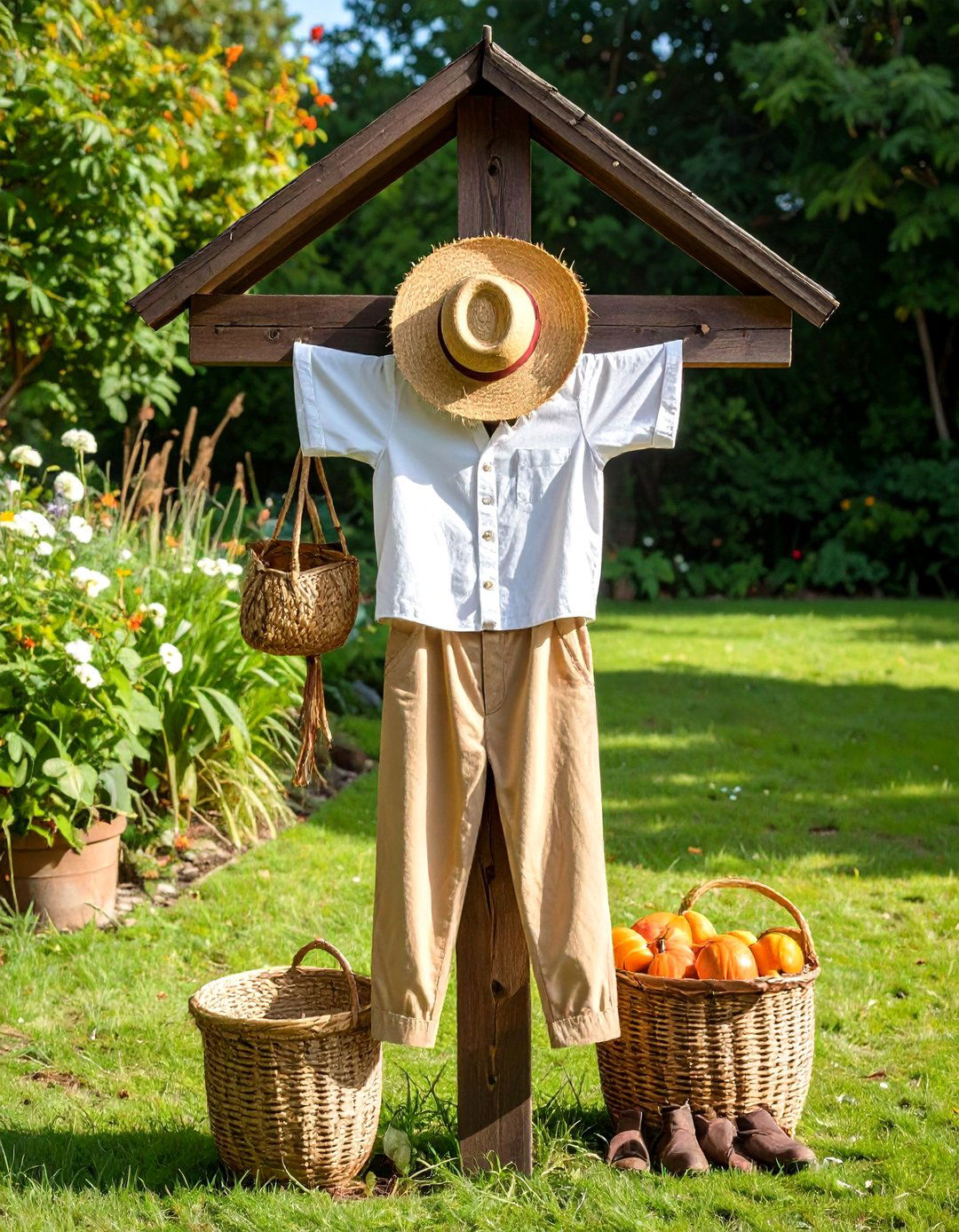
A sturdy wooden cross made from two 2×4s remains the simplest, time-tested base for a garden scarecrow. Begin by sinking the vertical post at least 30 cm into soil for wind stability, then lash the horizontal arm roughly shoulder-height. Fill old shirts and trousers with straw or dried leaves; these natural fillings drain quickly after rain and give authentic bulk. Add a pillow-case head, draw bold eyes, and top with a hat to break the rooftop line—birds notice that silhouette first. Move the frame weekly to new spots so pests never learn it’s harmless, a key tip echoed by extension specialists.
2. Recycled Plant-Pot “Pot-Man” Scarecrow

Consider turning that stack of empty nursery pots into a cheerful “Pot-Man” scarecrow. Thread rope through drainage holes to connect pots into arms and legs, then knot firmly so the segments clack in the breeze, adding sound deterrence. A large upturned bucket forms a whimsical head, and leftover exterior paint lets kids decorate a broad grin. The entire figure is light enough to hang from a crossbar or tree limb, swaying and rattling whenever wind gusts—movement that keeps crows cautious. By reusing plastic instead of buying new décor, you’ll reduce waste while giving your garden a quirky guardian.
3. Pool-Noodle Skeleton Scarecrow

A bright pool noodle slid over thin bamboo stakes creates a weather-proof, bendable skeleton perfect for lightweight scarecrows. Slice noodles lengthwise to fit over horizontal arms and notch joints so elbows pivot when breezes blow. Old flannel shirts slip easily over the foam, and stuffing isn’t required; the noodle’s girth already suggests shoulders. Because foam dries fast, mildew is minimal—a boon in humid climates. Repurposing inexpensive summer toys means you can rebuild quickly if sun fades colors or a storm snaps stakes, keeping year-round protection effortless and economical.
4. Reflective CD-and-Foil Scarecrow

Unlike static cloth figures, shimmering surfaces disorient birds that rely on sharp eyesight. Thread fishing line through holes in old CDs or pie-plate offcuts and attach them to outstretched scarecrow arms, allowing discs to spin freely. Light flashes at random angles, mimicking predator movement. For extra sparkle tape strips of aluminum foil along sleeves. Gardeners report the tactic works best in sunny plots and must be rearranged every few days for continued impact. Keep discs above leaf height so foliage doesn’t block the gleam.
5. Aromatic Herb-Stuffed Scarecrow

Surprisingly, strong scents can add a second defensive layer. Pack pouches of mint, lavender, or rosemary inside the scarecrow’s pockets; mammals like rabbits dislike these aromas. Replace herbs when fragrance fades—about every three weeks in hot weather. This dual-purpose dummy smells pleasant to humans yet unsettles small pests nosing for tender shoots. Pairing fragrance with the familiar humanoid outline multiplies deterrence without chemicals, aligning with integrated pest-management principles.
6. Motion-Activated Water-Sprinkler Scarecrow

A motion-activated sprinkler keeps both birds and larger intruders guessing—one startling jet and they flee. Mount the sensor unit on your scarecrow frame so it looks like an arm-held hose; the unexpected realism amplifies the scare. Many solar-charged models cover up to 1,200 sq ft and deliver only a cup or two per burst, conserving water. Adjust spray arc away from public paths to avoid drenching guests. Relocate the device every week so wildlife can’t map safe zones.
7. Solar-Powered LED-Light Scarecrow

By day it resembles a friendly farmer; by night, embedded LEDs flash predator-red or strobe white, unsettling nocturnal raiders. Clip flexible solar fairy lights around the hat brim and button line, routing the tiny panel to the shoulder. Alternatively, attach purpose-built solar bird-repeller units that combine flashing light with periodic sounds. Because power comes from the sun, no wiring crosses the lawn, and batteries recharge automatically for dusk-to-dawn vigilance.
8. Wind-Chime Melody Scarecrow
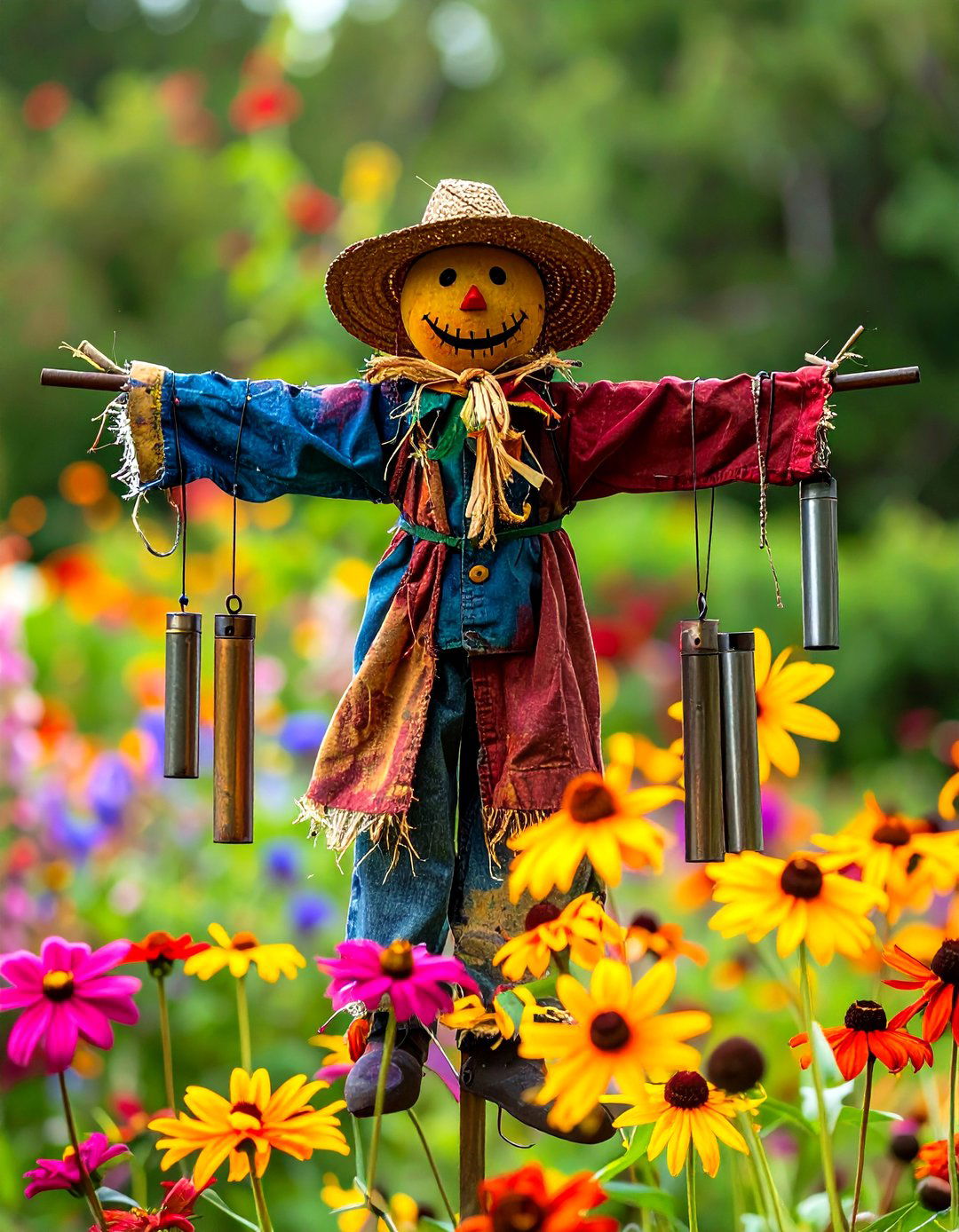
With breezes comes motion, so let your scarecrow sing. Suspend aluminum wind-chime tubes from the outstretched arms; high-pitched clangs change with every gust, preventing birds from acclimating. Choose corrosion-resistant metal for longevity, and secure cords firmly so heavy blows don’t tangle chimes around seedlings. Soft tones soothe gardeners even as unpredictable rhythms unsettle pigeons and starlings. For best effect, swap chime styles mid-season—wooden clacks in spring, gentle bell chimes in summer—to vary acoustic patterns.
9. Kid-Painted Terra-Cotta-Pot Scarecrow
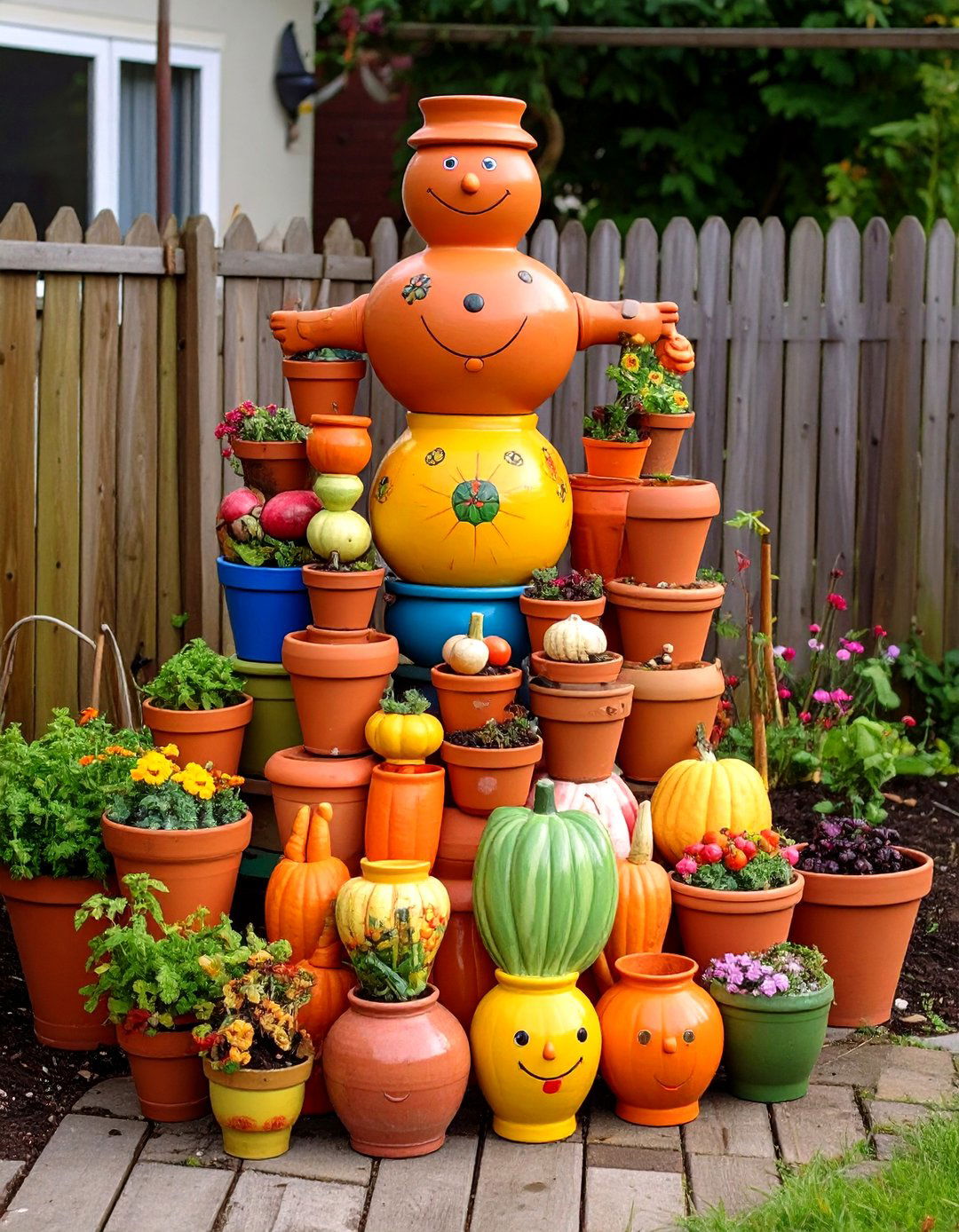
A row of stacked terra-cotta pots forms a barrel torso, while smaller pots create articulated arms and legs. Let children paint cheerful vegetable motifs or goofy faces before sealing with weather-proof varnish. Bright pigments provide visual contrast against green foliage, improving deterrence, and kids gain ownership of garden care. Drill drainage holes together so rainwater runs out, preventing mosquito breeding inside the pots. A bamboo rod through the stack secures the sculpture against tipping.
10. Festival-Theme Character Scarecrow

Looking to impress visitors? Design a scarecrow around a beloved storybook hero or local sports mascot, echoing community scarecrow-festival creativity. Oversized foam props and bold team colors draw human attention and avian suspicion alike. Display boards can invite neighbors to guess the character, sparking garden conversation. Swap costumes seasonally—superhero in summer, cozy snowman come winter—so the silhouette alters frequently, thwarting pest adaptation.
11. Owl-Decoy Hybrid Scarecrow

Traditional owl statues lose effect fast, but mounting one atop a full-figure scarecrow refreshes the ruse. Choose a decoy with bobble or rotating head; elevation grants a clear perch while the humanoid shape adds bulk. Combine this with reflective tape on wings for multi-sensory deterrence. Remember to move both post and owl every few days; studies find static decoys quickly fail.
12. Laser-Light High-Tech Scarecrow

For fruit plots endangered by dusk-feeding flocks, a low-power green-laser module attached to a scarecrow’s arm sweeps random beams across leaves. Research in sweet-corn fields shows laser scarecrows can cut bird damage dramatically when deployed before the first ripening day. Secure the module to pivot slowly via small servo or oscillating fan motor for wider coverage, and shut it off during full daylight when beams are less visible.
13. Pollinator-Friendly Flower-Crown Scarecrow

Despite its name, a scarecrow can welcome bees. Fashion a crown of drought-tolerant blossoms—marigold, cosmos, alyssum—around the hat brim. Birds ignore colors insects adore, and the flowering halo feeds beneficial pollinators while giving the guardian a jubilant look. Re-pot crown plants into a shallow tray you can lower for watering, keeping living elements healthy all season.
14. Seasonal Costume Switch-Out Scarecrow
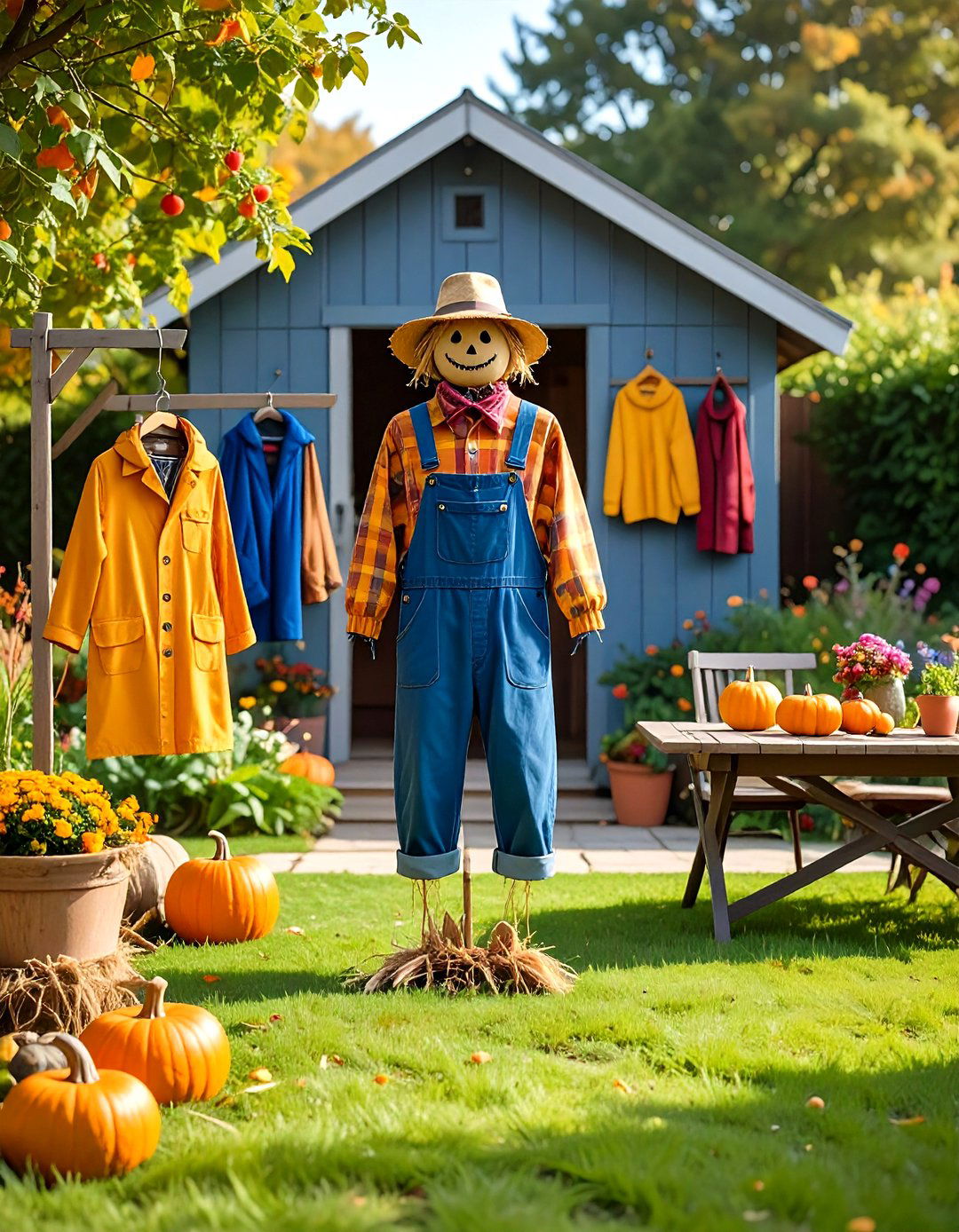
Rotating attire every fortnight keeps both birds and passers-by intrigued. Summer overalls can morph into a raincoat, then a harvest sweater. Rapid costume change means minimal storage: keep a tote of outdated clothes near the shed. Rapid visual variety is a cornerstone of effective scare tactics, discouraging habituation documented by horticultural experts.
15. Upcycled Clothesline Scarecrow
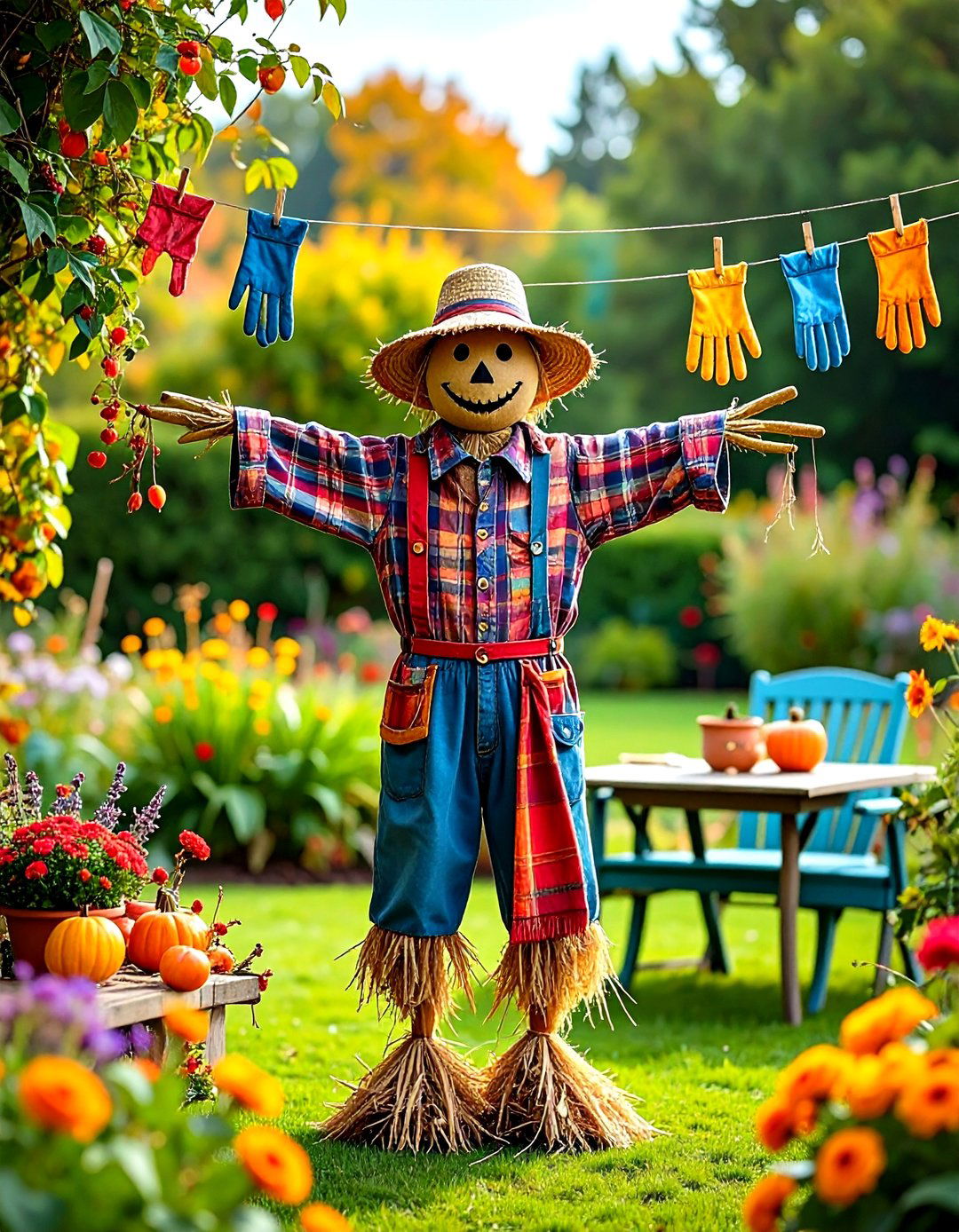
String a horizontal wire across two posts and hang assorted shirts and straw-stuffed gloves so they flutter like ghostly dancers. Add a burlap-sack face at center to personify the mobile display. As garments sway independently, patterns of movement stay unpredictable, excellent for wide beds where a single post might leave blind spots. Choose light, quick-dry fabrics to avoid sagging after storms.
16. Hanging Bottle-Rattle Scarecrow
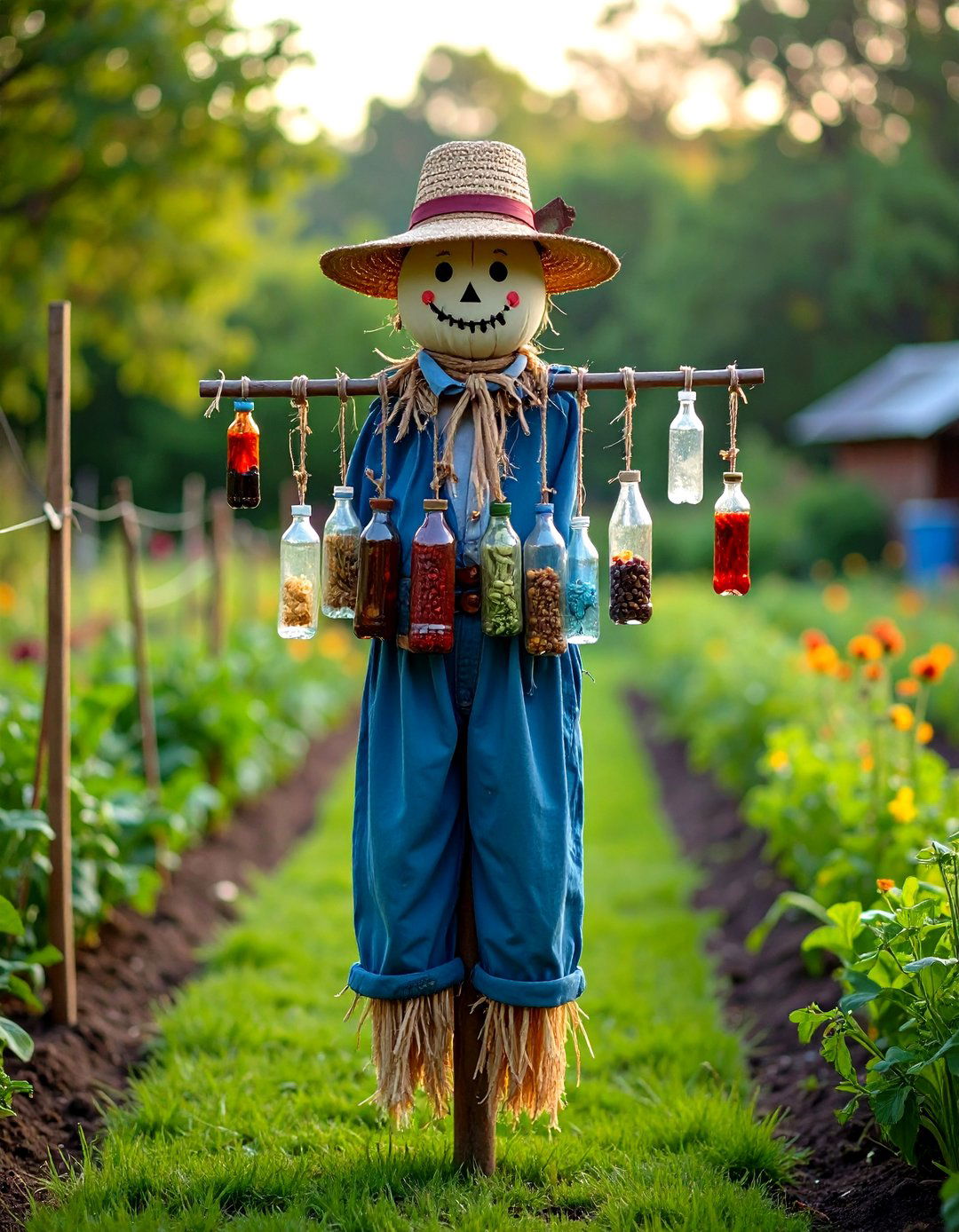
Plastic drink bottles half-filled with dried beans become lightweight noisemakers. Suspend several from arm tips with garden twine, poking small holes at the top so wind whistles through. Daytime sun flashes on clear plastic, while nighttime breezes clatter the beans—dual-period coverage for little cost. Replace beans with pebbles if humidity causes swelling.
17. Community 4-H Team-Build Scarecrow

Group projects foster ownership. Follow youth-program guidelines that encourage any safe material—wood, metal, or fabric—and let participants vote on design. Collaboration teaches tool skills and garden stewardship while producing a bigger, bolder guardian than one person might craft alone. Posting a sign crediting the team adds pride and deters tampering.
18. Integrated-Pest-Management Moving Scarecrow

Many pests adapt quickly, so integrate your scarecrow into a rotation of tactics. Shift its position, add portable speakers with random predator calls, and combine with netting during peak fruiting. Extension handbooks stress that frightening devices must precede pest arrival for best results and work in tandem with habitat management. Schedule calendar reminders to relocate the guardian twice weekly.
19. Mini Veggie-Patch Scarecrow Stakes

Seedlings suffer most from marauding sparrows. Drive short bamboo stakes topped with felt faces at row ends to create a line of baby scarecrows. Because they sit closer to ground level, birds perceive multiple “eyes” monitoring them. Paint expressions in bright yellows and reds—colors birds notice first—then reposition as plants grow taller.
20. Storybook Character Scarecrow for Kids
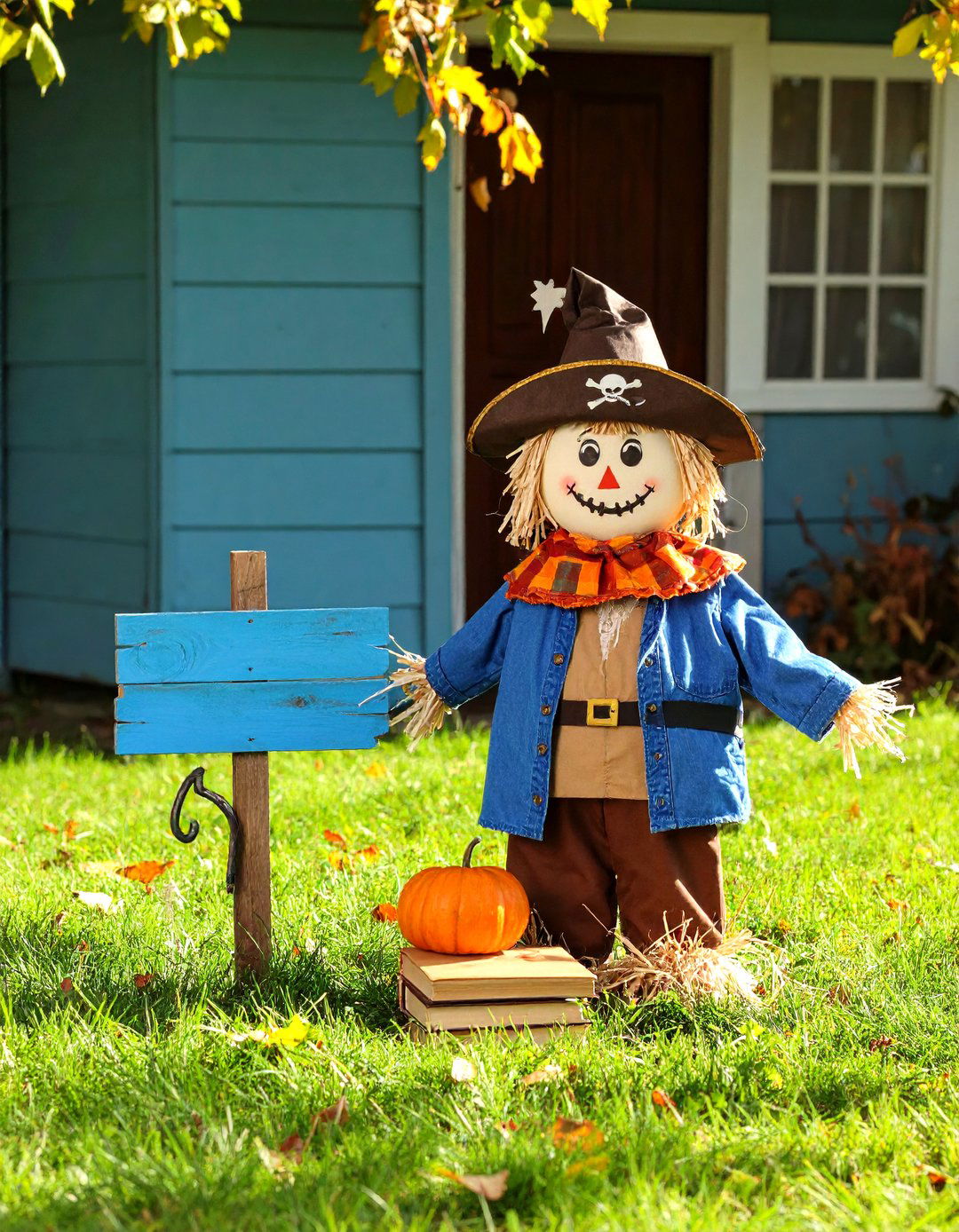
Finally, turning favorite characters into scarecrows sparks children’s imagination and keeps them eager to weed around their creation. Use cardboard accessories—wizard hats, pirate hooks—sealed with outdoor varnish, and encourage weekly story time beside the guardian. Regular attention means you naturally adjust placement and clothing, preventing wildlife familiarity. Craft blogs note that pairing reading with building deepens both literacy and garden care habits.
Conclusion:
A garden scarecrow needn’t be a static straw sentinel; it can flash light, splash water, smell like herbs, chime melodies, and evolve with the seasons. Whether you favor recycled plastics, solar tech, or community artistry, the crucial lesson is variation—shape, sound, scent, and position must shift so wildlife never grows comfortable. By blending tradition with innovation across these twenty ideas, you’ll craft guardians that protect produce, invite pollinators, engage kids, and showcase your creative spirit, all while aligning with sustainable, people-first gardening practices.









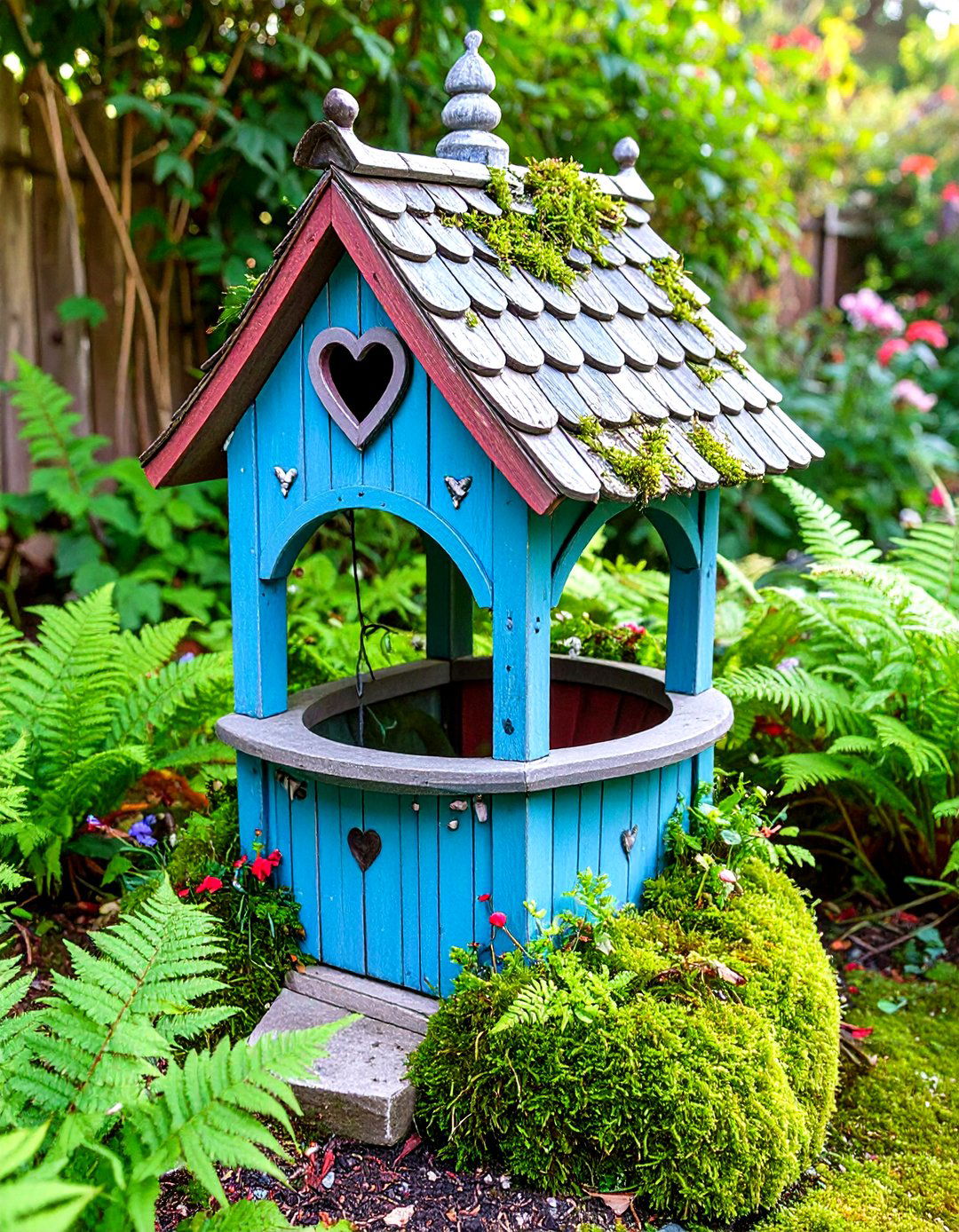



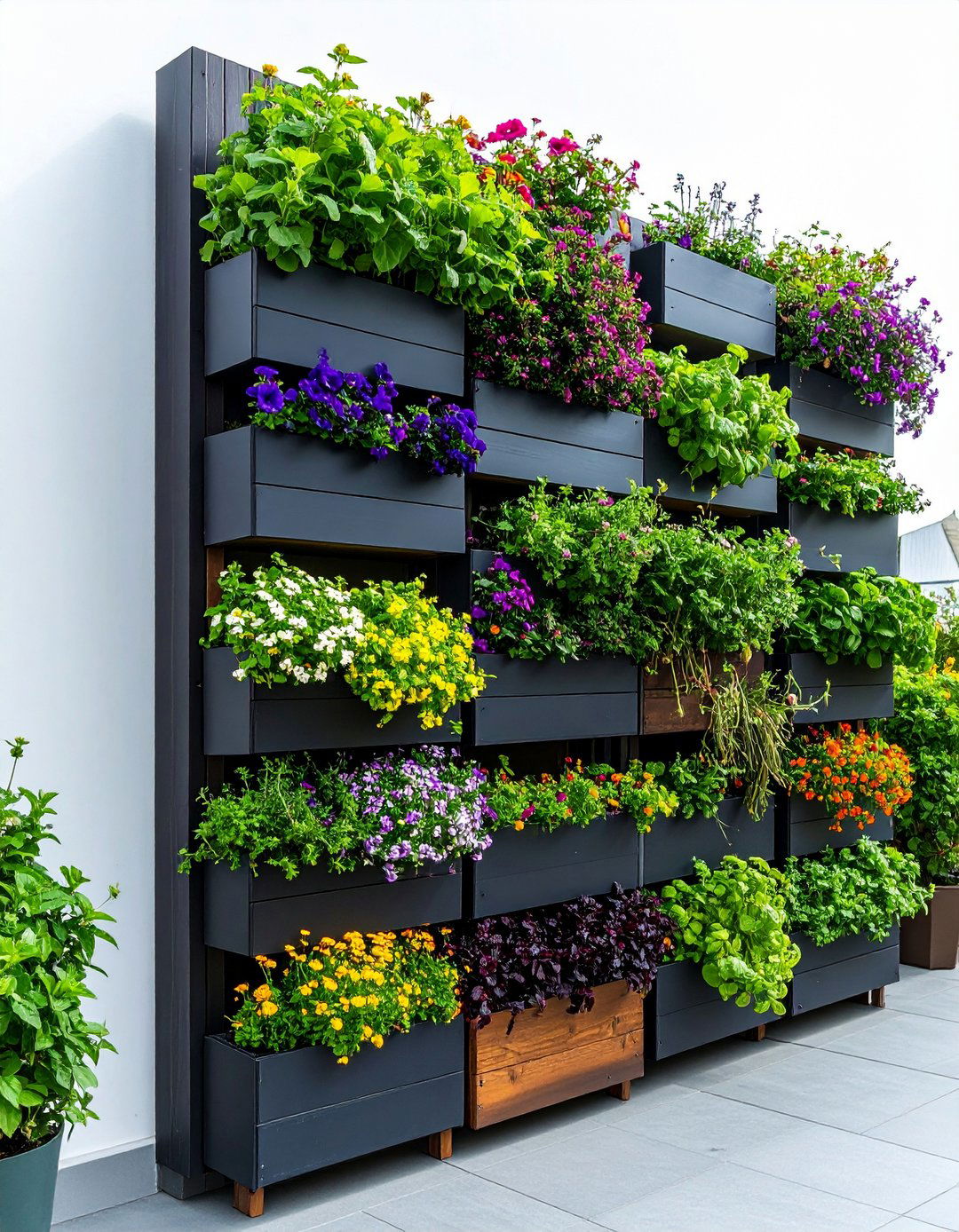


Leave a Reply